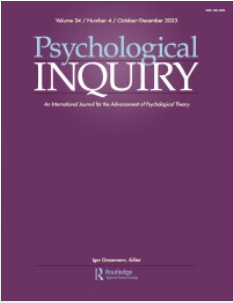Homeostasis, Interrupted: Living with and Recovering from a Stigmatized Identity
IF 4.1
2区 心理学
Q1 PSYCHOLOGY, MULTIDISCIPLINARY
引用次数: 0
Abstract
There is much to admire about Sedikides’ (this issue) homeostatic model of identity maintenance. In brief, Sedikides argues that people possess a psychological immune system that helps them to maintain psychological homeostasis; “a routine, adaptive, process by which people monitor their internal and external environments for threats to their selfviews or, more generally, to their theories about their characteristics, relationships, and circumstances” (p. 215). The scope and complexity of the model effectively incorporate theories and empirical findings from the sprawling literature about the self, and thus provides an overarching structure apt to organize the field. The model’s focus on mind-body connections is also a welcome return to a holistic self-psychology that seemed lost for a while, but whose resurgence in recent years raises new questions and offers new opportunities for interdisciplinary cross-pollination. Framing the mechanisms that uphold a coherent sense of self as an immune system further emphasizes the inherently intertwined biological and psychological components of human life. Yet despite all of these strengths and the importance of the model as a whole, if we are being totally honest—and that seems to be the goal here—we suspect that some people could feel alienated when reading this paper. We agree that most people must contend with daily feedback that refutes their generally-positive self-views, including negative feedback from an employer, poor performance on a task for which they believe they are highly skilled, and criticism by a friend—all examples that Sedikides uses to illustrate his model—and we agree that those kinds of experiences can be highly distressing. Yet, when some people read those examples, a tiny voice in their heads may whisper, “That must be nice!” It must be nice to live in a social world where identity-threats can be easily countered if one “construe[s] their experiences optimistically” or “recall[s] selectively favorable information” (Sedikides, this issue, p. 211). It must be nice to enjoy positive self-views that meet “... survival and reproductive needs, including physical and social attractiveness, intellectual prowess, self-regulatory proficiency, and social status” (Sedikides, this issue, p. 197). It must be nice to have a psychological system whose primary goal is to simply feel good. Unfortunately, for people who possess one or more intersecting identities that are subject to social devaluation, or stigma, this is not always their lived reality, and we think that this perspective is missing from Sedikides’ model. This oversight is epistemologically costly, because from a population demographic perspective, most people possess characteristics or belong to groups that are subjected to stigma, and most of them belong to multiple stigmatized groups (Pachankis et al., 2018; Reinka, Pan-Weisz, Lawner, & Quinn, 2020). The proportion of the population that is disabled, fat, queer, or who are Black, Indigenous, or people of color living in postcolonial/settler societies like the US and Canada—to name just a few possible intersecting and stigmatized identities—far outnumbers the proportion of the population who belong to none of these groups, even in societies where each group is a “minority” on its own. Indeed, this is how hegemonic social systems that foster stigma are designed to operate: the few dominate the many, and part of that domination includes overlooking and excluding “non-normative” lived experiences (e.g., Bos, Pryor, Reeder, & Stutterheim, 2013). We would like to take this opportunity, then, to explore how Sedikides’ (this issue) impressive, thorough, and compelling homeostatic model of identity maintenance could be expanded to explain the experiences of people who not only must struggle to survive in social environments that would rather they did not exist, but must also struggle to live with and recover from the psychological consequences of that trauma. Thus, in the discussion that follows, we explore how Sedikides’ model can be expanded to explain the experiences of people who must live with, and hopefully one day recover from, social stigma.稳态,中断:与被污名化的身份共存并从中恢复
Sedikides(本期)的身份维持稳态模型有很多值得钦佩的地方。简而言之,Sedikides认为,人们拥有一个心理免疫系统,可以帮助他们维持心理稳态;“一个常规的、适应性的过程,人们通过这个过程来监控他们的内部和外部环境,以寻找对他们的自我观点的威胁,或者更广泛地说,对他们关于自己的特征、关系和环境的理论的威胁”(第215页)。该模型的范围和复杂性有效地结合了关于自我的大量文献中的理论和经验发现,从而提供了一个易于组织该领域的总体结构。该模型对身心联系的关注也是对整体自我心理学的一次可喜的回归,这种心理学似乎已经消失了一段时间,但近年来它的复兴提出了新的问题,并为跨学科交叉授粉提供了新的机会。构建维持自我作为免疫系统的连贯感的机制,进一步强调了人类生活中固有的相互交织的生物和心理组成部分。然而,尽管有所有这些优势和整个模型的重要性,如果我们完全诚实——这似乎是我们的目标——我们怀疑有些人在阅读这篇论文时可能会感到疏远。我们同意,大多数人必须面对反驳他们普遍积极的自我观点的日常反馈,包括雇主的负面反馈、他们认为自己非常擅长的任务表现不佳,以及朋友的批评——所有这些都是Sedikides用来说明他的模型的例子——我们也同意,这些经历可能会非常令人痛苦。然而,当一些人读到这些例子时,他们脑海中可能会有一个微弱的声音在窃窃私语,“那一定很好!”生活在一个社会世界里,如果一个人“乐观地解释自己的经历”或“选择性地回忆有利的信息”,那么身份威胁就很容易得到应对,这一定很好(Sedikides,本期,第211页)。享受满足“…生存和生殖需求,包括身体和社会吸引力、智力、自律能力和社会地位”的积极自我观一定很好(Sedikides,本期,第197页)。拥有一个以感觉良好为主要目标的心理系统一定很好。不幸的是,对于那些拥有一个或多个交叉身份、受到社会贬低或污名化的人来说,这并不总是他们的生活现实,我们认为Sedikides的模型中缺少这一观点。这种监督在认识论上代价高昂,因为从人口统计学的角度来看,大多数人都具有特征或属于遭受污名化的群体,而且他们中的大多数人属于多个污名化群体(Pachankis et al.,2018;Reinka、Pan-Weisz、Lawner和Quinn,2020)。生活在美国和加拿大等后殖民/定居者社会中的残疾人、肥胖者、酷儿、黑人、原住民或有色人种的比例——仅举几个可能的交叉和污名化身份——远远超过不属于这些群体的人口比例,即使在每个群体都是“少数群体”的社会中也是如此。事实上,助长污名化的霸权社会制度就是这样运作的:少数人支配多数人,这种支配的一部分包括忽视和排斥“非规范”的生活经历(例如,Bos、Pryor、Reeder和Stutterheim,2013)。因此,我们想借此机会,探索Sedikides(这个问题)令人印象深刻、彻底和令人信服的身份维护稳态模型是如何扩展的,以解释人们的经历,他们不仅必须在宁愿自己不存在的社会环境中挣扎求生,但也必须努力忍受这种创伤的心理后果并从中恢复过来。因此,在接下来的讨论中,我们探讨了如何扩展Sedikides的模型,以解释那些必须与社会污名共存的人的经历,并希望有一天能从社会污名中恢复过来。
本文章由计算机程序翻译,如有差异,请以英文原文为准。
求助全文
约1分钟内获得全文
求助全文
来源期刊

Psychological Inquiry
PSYCHOLOGY, MULTIDISCIPLINARY-
CiteScore
10.30
自引率
1.10%
发文量
31
期刊介绍:
Psychological Inquiry serves as an international journal dedicated to the advancement of psychological theory. Each edition features an extensive target article exploring a controversial or provocative topic, accompanied by peer commentaries and a response from the target author(s). Proposals for target articles must be submitted using the Target Article Proposal Form, and only approved proposals undergo peer review by at least three reviewers. Authors are invited to submit their full articles after the proposal has received approval from the Editor.
 求助内容:
求助内容: 应助结果提醒方式:
应助结果提醒方式:


